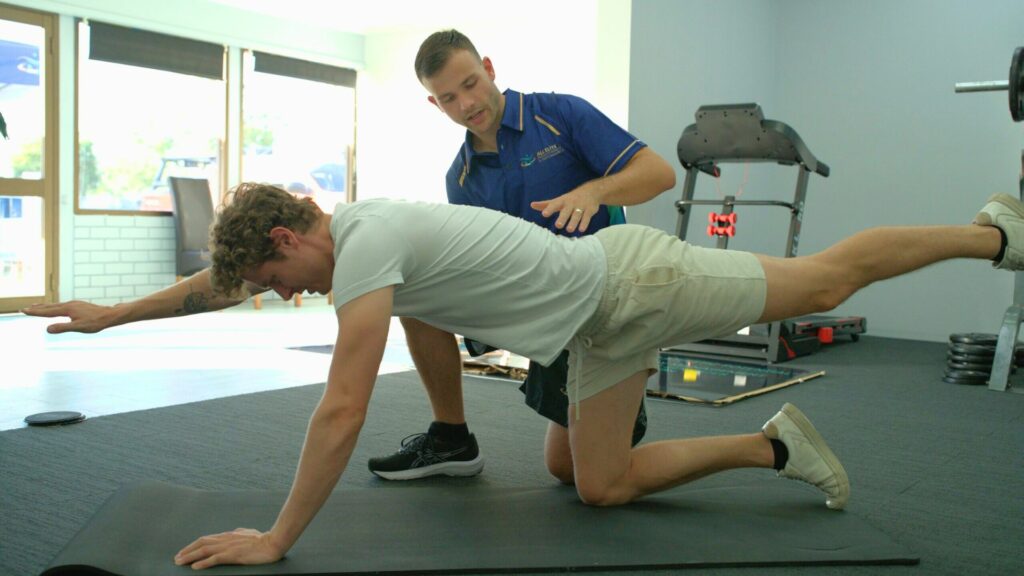Physio vs Chiro: Which One is Better for Sports Injuries?
Key Takeaways
- Physiotherapy provides a more comprehensive approach to sports injuries, focusing on long-term recovery, prevention, and improved performance.
- Chiropractic care can be effective for spinal alignment and symptom relief, but it is generally narrower in scope compared to physio.
- The best choice often depends on the type of injury, with physio being the go-to for muscle, ligament, and rehabilitation needs.
- Considering cost, time, and evidence-based outcomes, physiotherapy is usually the more effective option for athletes and active individuals.
When dealing with sports injuries, the right healthcare professional can make all the difference to your recovery, return to sport, and long-term performance. One of the most common questions athletes ask is:
Should I see a physio or a chiropractor?
At All Elite Physiotherapy and Performance, we believe understanding the key differences between physiotherapy and chiropractic care empowers athletes, active individuals, and health-conscious adults to make informed choices. While both disciplines offer value, their focus is different.
Chiropractic care often addresses spinal alignment and related issues, while physiotherapy takes a more comprehensive approach. It targets not just symptoms but also the underlying causes of sports injuries to support long-term recovery and performance.
Understanding Each Profession
What Does a Physiotherapist Do?
Physiotherapy is a treatment approach that focuses on rehabilitation, functional movement, and overall mobility, particularly managing pain, to get you back to peak athletic performance. Physios treat musculoskeletal conditions through evidence-based practice to alleviate pain, enhance recovery, and prevent future injuries.

Common physio techniques include:
- Exercise Prescription: Customised programs to strengthen muscles, improve mobility, and reduce pain.
- Soft Tissue Massage: Hands-on techniques to relieve pain, reduce muscle tension, and promote healing.
- Manual Therapy: Joint mobilisation and manipulation to restore optimal movement patterns.
- Dry Needling: Targeting trigger points for pain relief and enhanced muscle function.
- Patient Education: Lifestyle adjustments and self-care practices to reduce injury recurrence.
What Does a Chiropractor Do?
Chiropractic care primarily focuses on spinal alignment, joint manipulation, and the relationship between the spine and nervous system. It uses manual adjustments to relieve pain, particularly chronic spinal-related issues.
Common chiro techniques include:
- Spinal Manipulation (Adjustments): Manual adjustments to restore proper alignment.
- Joint Mobilisation: Gentle movements to alleviate joint stiffness.
- Postural Correction: Advice and adjustments to improve posture.
- Hands-on Manipulation: Direct manual techniques primarily targeting spinal issues.
Key Differences Between Physio and Chiro

Approach to Injury Prevention & Rehab
This is where physiotherapists focus on taking a comprehensive, proactive approach, often with a holistic treatment plan. Physios don’t just relieve pain but also help the body heal by addressing the underlying movement patterns that cause injury and other related health issues. Treatment is goal-oriented and evidence-based based so you have a clear path to full recovery and overall health.
Chiropractic care is narrower, often focused on immediate relief of symptoms related to spinal alignment or nervous system issues. While effective for some conditions, chiropractic care can miss broader musculoskeletal and functional considerations for athletes.
When to See a Physio
- Muscle Strains and Tears: Physio treats muscle injuries with targeted rehabilitation exercises.
- Ligament Injuries (e.g. ACL tears, ankle sprains): Structured recovery programs to get you back to sport safely.
- Shoulder and Joint Pain: Holistic treatments to improve joint function and reduce pain.
- Post-Surgical Rehabilitation: Detailed rehabilitation plans to ensure optimal recovery after surgery.
When to See a Chiro
- Chronic Back Pain and Neck Pain: Primarily related to spinal misalignment.
- Headaches related to Spinal Dysfunction: Chiropractic care for immediate symptomatic relief.
- Minor Spinal Alignment Issues: Regular adjustments to maintain spinal health.
Why Physiotherapy is More Comprehensive
Physiotherapy combines multiple treatment methods such as exercise programs, manual therapy, and education, which makes it more comprehensive for long-term recovery. This sets it apart from chiropractic adjustments, which are often limited to short-term relief.

Detailed Benefits of Physio for Sports Injuries
- Customised Treatment Plans: Specific, individualised rehabilitation plans for each athlete’s unique injury.
- Long-term solutions: Beyond pain relief, physio focuses on prevention and functional performance.
- Holistic Approach: Combines manual therapy, massage, and exercise to address the injury comprehensively.
- Improved Mobility and Performance: Supports both recovery and athletic improvement through structured rehabilitation exercises that target both the injured area and supporting muscles.
Insurance, Costs & Rebates in Australia
Both physiotherapy and chiropractic care attract private health rebates. Medicare provides limited rebates through a GP referral for chronic conditions. Check with your provider for costs and coverage.
Cost and Time Commitment: Physio vs Chiro
One of the biggest practical questions athletes ask is how much time and money they will need to invest.
- Physiotherapy: Treatment often involves structured programs with exercises, progress reviews, and manual therapy. While the upfront time commitment can be higher, long-term outcomes tend to be stronger because physio addresses the underlying problem. This can mean fewer relapses and fewer appointments in the long run.
- Chiropractic Care: Many people see a chiropractor for shorter sessions aimed at immediate relief, such as spinal adjustments. While the sessions may be quicker, patients often require ongoing visits to maintain results.
For most sports injuries, physiotherapy is the more cost-effective solution over time because it reduces the risk of re-injury and builds long-term strength and mobility.
What the Research Says
Physiotherapy Leads the Way
The evidence and support of physiotherapy interventions, including certain exercises for sports injuries, is greatly supported by numerous systematic reviews, meta-analyses, and clinical practice guidelines from leading sports medicine authorities globally.
- Exercise is the King for Sports Injuries: Decades of research confirm that specific, progressive exercise prescription is the most effective intervention for a vast range of musculoskeletal conditions affecting athletes. This includes superior outcomes for tendinopathies, ligament sprains (especially ACL and ankle, muscle injuries, and chronic pain states.
- Rehabilitation Protocols Deliver Results: Structured, physio-led rehabilitation programs for post-operative recovery (e.g., ACL reconstruction) consistently lead to better functional outcomes, higher rates of return to sport, and lower re-injury rates.
- Manual Therapy as a Powerful Adjunct: When combined with exercise, techniques like joint mobilisation and soft tissue work effectively reduce pain, improve range of motion, and facilitate better engagement in active therapies.
- Focus on Functional Outcomes & Prevention: Physiotherapy research consistently emphasizes long-term functional improvement, successful return to sport, and strategies to prevent future injuries, which are paramount for athletes.
Evidence-Based Benefits of Chiropractic Care
Research supports chiropractic care, particularly spinal manipulation, for certain conditions.
Clinical guidelines acknowledge spinal manipulation as a viable option for acute and chronic non-specific low back pain and some types of neck pain and headaches.
Many studies on "sports chiropractic" for extremity conditions either show limited benefits beyond placebo or incorporate multiple modalities (including exercise, similar to physiotherapy), making it difficult to attribute positive outcomes solely to chiropractic adjustments. The rationale for how a spinal adjustment would directly resolve, for example, a complex rotator cuff tendinopathy or an ACL tear is not well supported by current sports medicine science.
So while chiropractic care can be useful for spinal issues, physiotherapy’s evidence-based, comprehensive, and active approach makes it a better choice for the vast majority of injuries seen in sports.
Common Sports Injuries and Who Treats Them Best
Every sport carries its own risks, and athletes often wonder which professional is best for their type of injury.
- Hamstring Strains: Physio is best, as rehabilitation exercises and progressive loading are essential.
- ACL Tears or Sprains: Physio-led programs are critical for structured rehab and safe return to sport.
- Rotator Cuff Injuries: Physio provides mobility work, strengthening, and pain relief techniques.
- Chronic Lower Back Pain: Chiro can assist with adjustments, while physio addresses core strength and long-term movement correction.
- Ankle Sprains: Physio ensures progressive rehab and balance training to prevent recurrence. Learn more about ACL injuries, their causes, symptoms, and treatment.
Myths and Misconceptions About Physio and Chiro
Many people make decisions based on myths. Clearing these up helps patients make informed choices.
- “Chiropractic is just cracking backs.” In reality, chiropractic care involves more than adjustments and includes advice on posture and joint health.
- “Physio is only for post-surgery.” Physiotherapists treat a wide range of injuries, from minor sprains to chronic pain.
- “One session will fix everything.” Both physio and chiro usually require ongoing care. True recovery involves multiple sessions and commitment from the patient.
- “Exercises are optional in recovery.” Research shows exercise is the single most effective treatment for sports injuries. Skipping rehab exercises delays recovery and increases re-injury risk.
Choosing the Right Practitioner for You
Questions to Ask Before Booking
- What experience do you have with my injury?
- What treatment methods do you use?
- How long will recovery take?
- What evidence supports your chosen treatment?
Key Credentials and Experience to Look For
- Physiotherapists: Bachelor’s degree or higher, with postgraduate qualifications in sports physiotherapy.
- Chiropractors: Chiropractic-specific degrees with an emphasis on spinal and joint manipulation.
At All Elite Physiotherapy and Performance, our physiotherapists are medical professionals with a bachelor’s degree or higher and additional postgraduate qualifications in sports physiotherapy, and may recommend exercises and have specific experience in sports injury management, so you can be sure of a safe and effective path to full recovery.
Identifying the Specific Needs of Your Sports Injury
Every sports injury requires an individualised approach. Physiotherapists excel at identifying functional limitations, muscular imbalance, and movement inefficiencies, addressing not just symptoms but underlying causes to effectively decrease pain , so the body can heal effectively.
Chiropractic care may complement physiotherapy for some musculoskeletal disorders , but is typically limited to spinal alignment issues, so physiotherapy is the more comprehensive choice for overall athletic recovery and performance.
Can You See Both?
Seeing both physiotherapy and chiropractic care can be beneficial. This works best when:
- Chiropractic adjustments support broader rehabilitation goals set by your physiotherapist.
- Both practitioners work together with aligned treatment goals.
- Athletes have spinal alignment issues and broader musculoskeletal injuries that require comprehensive rehabilitation.
In most cases, physiotherapy alone provides all the treatment and rehabilitation needed for sports injuries.
Final Thoughts: Making the Smart Choice for You
Choosing physiotherapy for sports injury management gives you comprehensive, holistic, and evidence-based care. At All Elite Physiotherapy and Performance, our experienced physiotherapists create personalised treatment plans to support recovery, long-term health, and peak performance.
If you’re dealing with sports-related injuries and need expert advice, contact All Elite Physiotherapy and Performance today.
Frequently Asked Questions
Is chiro good for sports injuries?
Chiropractic care can treat specific spinal-related conditions, but may not address broader musculoskeletal sports injuries.
Should I see a chiropractor or physio?
Physiotherapy generally provides more comprehensive care, addressing symptoms and underlying causes for sustainable recovery.
Is chiro or physio better for a slipped disc?
Both can reduce pain, but physiotherapy usually provides structured rehabilitation exercises beyond just alignment.
Is chiro or physical therapy better?
Physical therapy (physiotherapy) usually provides better and longer-lasting recovery outcomes for sports injuries, for overall mobility, and injury prevention.
